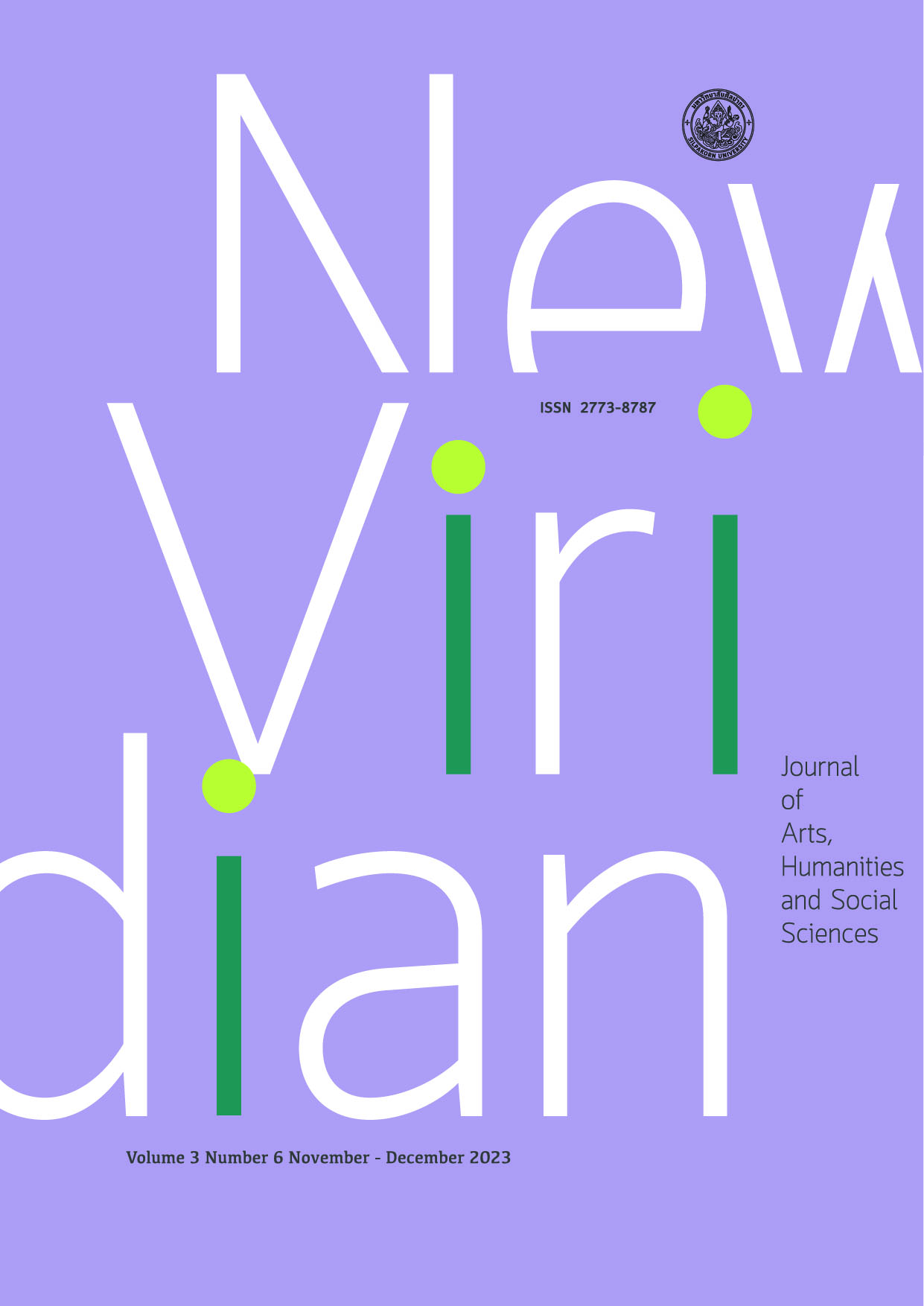การพัฒนาความสามารถด้านการอ่านภาษาอังกฤษเชิงวิจารณ์ตามหลักสุนทรียสนทนา สำหรับนักศึกษาระดับปริญญาตรี ชั้นปีที่ 3 สาขาวิชาภาษาอังกฤษ คณะศิลปศาสตร์ มหาวิทยาลัยกรุงเทพธนบุรี (The Development of English Critical Reading Abilities Based on the Processes of Dialogue for Third Year Undergraduate English Major Students, Faculty of Liberal Arts, Bangkokthonburi University)
Keywords:
English critical reading, DialogueAbstract
The purposes of this research were to 1) compare the students’ English critical reading ability before and after learning based on the Processes of Dialogue, 2) study the students’ expression of tacit knowledge during learning based on the Processes of Dialogue, and 3) study the opinions of third-year undergraduate students toward learning based on the processes of dialogue. The target group was composed of 32 third-year undergraduate students, English majors, at the Faculty of Liberal Arts at Bangkokthonburi University. In addition, the research instruments were 1) 5 learning plans, 2) the critical English reading abilities test (pre- and post-test) consisted of 30 items, 3) the tacit knowledge record form, and 4) the questionnaire survey of students’ opinions toward learning based on the Processes of Dialogue. The percentage, mean (X̅), standard deviation (S.D.) and dependent t-test were applied for data analysis. The results after learning based on the Processes of Dialogue in 5 steps were 1) the students’ English critical reading abilities after learning was significantly higher than before learning at the 0.05 level, 2) The students’ expression of tacit knowledge between the 1st week and the 5th week showed a consistently growing percentage, and 3) The undergraduate students’ opinions towards the learning based on the Processes of Dialogue were positive at a good level (X̅ = 4.14, S.D. = 0.67)
References
Aksorndej, Natcha. (2011). Construction of Drill Package on Reading for Comprehension for Mathayomsuksa 2 Students (การสร้างแบบฝึกทักษะการอ่านจับใจความสำคัญ สำหรับนักเรียนชั้นมัธยมศึกษาปีที่ 2). Master’s dissertation, Burapha University, Chonburi, Thailand.
Attawong, Patnaree, Suwannapa, Chaweewan, & Chanchamrat, Teerawat. (2013). Factors Affecting the Reading Behavior According to the Opinion of the Students of Mahachulalongkornrajavidyalaya University, Phrae Campus (ปัจจัยที่ส่งผลต่อพฤติกรรมการอ่านตามความเห็นของนิสิต มหาวิทยาลัยมหาจุฬาลงกรณราชวิทยาลัย วิทยาเขตแพร่). [Online]. Retrieved November 1, 2022 from https://www.mcu.ac.th/article/detail/292
Bohm, D. (1996). On Dialogue. NY: Routledge.
British Council. (2022). 5 Ways to Improve Your Speaking Skills (5 วิธีเพิ่มความกล้าในการพูดภาษาอังกฤษ). [Online]. Retrieved November 1, 2022 from https://www.britishcouncil.or.th/english/tips/improving-your-speaking-in-only-5-steps
Ennis, R. H. (1962). A Concept of Critical Thinking. Harvard Educational Review, 32(1): 81-111.
Krathwohl, D. R. (2002). A Revision of Bloom’s Taxonomy: An Overview. Theory into Practice, 41(4): 212-218. [Online]. Retrieved November 1, 2022 from https://www.depauw.edu/files/resources/krathwohl.pdf
Nillapun, Maream. (2015). Research Methodology in Education (วิธีวิจัยทางการศึกษา) (9th ed.). Nakhon Pathom: Silpakorn University Printing House.
Panich, Vicharn. (2012). Ways of Building Learning for Students in the 21st Century (วิถีสร้างการเรียนรู้เพื่อศิษย์ ในศตวรรษที่ 21). Bangkok: Tathata Publication.
Pinitjitsamut, Montchai. (2009). Dialogue, Aesthetic Conversation: The Science of Creation. The Collective Intelligence of Human Beings (Dialogue สุนทรียสนทนา: ศาสตร์แห่งการสร้างสรรค์สติปัญญาร่วมกันของมนุษย์). Samut Prakan: Jong Jaroen Offset.
Po Ngern, Wisud. (2013). Using of Dialogue to Develop Question Abilities for Bachelor Degree Students in the Department of Elementary Education, Faculty of Education Silpakorn University (การใช้สุนทรียสนทนาเพื่อพัฒนาความสามารถในการตั้งคำถามของนักศึกษาระดับปริญญาตรี สาขาวิชาการประถมศึกษา คณะศึกษาศาสตร์ มหาวิทยาลัยศิลปากร). Silpakorn Educational Research Journal, 5(1): 21-33.
Poovorawan, Yong. (2021). New Normal Life with New Media (ชีวิตวิถีใหม่กับสื่อใหม่). [Online]. Retrieved November 1, 2022 from https://learningdq-dc.ku.ac.th/course/?c=6&l=1
Ruangsakul, Nawaporn. (2014). Spring at Bellagio: Aesthetic Conversation of Wisdom at Sir Belloni Castle (ใบไม้ผลิที่ Bellagio: สุนทรียสนทนาแห่งปัญญา ณ ปราสาทเซอร์เบลโลนี). Bangkok: KnowledgePlus.
Rumelhart, D. E. (1977). Toward an Interactive Model of Reading. In S. Dornic (Ed.), Proceedings of the Sixth International Symposium on Attention and Performance, (pp. 573-604). NJ: Lawrence Erlbaum Associates Publishers.
Sirisai, Sorot. (2006). Dialogue: A New Dimension of Stage Performance for Villagers (Dialogue: มิติใหม่ของการจัดเวทีชาวบ้าน). Journal of Language and Culture, 25(2): 38-49.
Stauffer, B. (2022). What are 21st Century Skills? [Online]. Retrieved November 1, 2022 https://www.icevonline.com/blog/what-are-21st-century-skills
Suwanbubpha, Parichart. (2010). Manual for Organizing the Dialogue Process (คู่มือการจัดกระบวนการสานเสวนา). Nakhon Pathom: The Research Center for Peacebuilding, Mahidol University.
Thakan, Wallapa. (2020). Deep Listening (การฟังอย่างลึกซึ้ง). [Online]. Retrieved November 1, 2022 from http://hsmi2.psu.ac.th/upload/forum/paper_1516_5f0ab2e81b82a5f0ab2.pdf
Thammongkol, Kanda. (1983). Critical Reading in English (การอ่านภาษาอังกฤษเชิงวิจารณ์). Pasaa Paritat Journal, 4(2): 26-41.
Yoongtong, Peanporn, Kajonrungsilp, Suchinda, & Chaisooksung, Sunee. (2015). The Application of Dialogue in the Nursing Value Training Program (การประยุกต์ใช้กระบวนการสุนทรียสนทนาในการจัดการเรียนการสอนคุณค่าการเป็นพยาบาล). Region 3 Medical and Public Health Journal, 12(2): 24-35.


